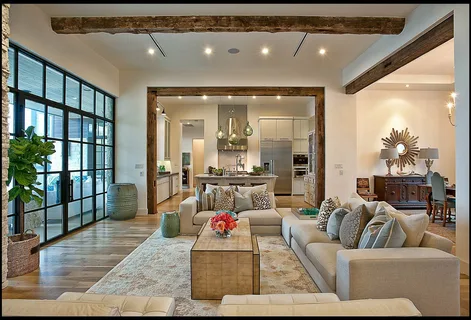Classic Interior Design Principles for Modern Living

In the world of interior design, certain principles stand the test of time, transcending fleeting trends and fads. These principles, rooted in classic design philosophies, provide a solid framework for creating spaces that are both functional and aesthetically pleasing. Whether designing a cozy home or a grand mansion, understanding and applying these principles can elevate the ambiance and appeal of any interior space.
Harmony and Balance
Harmony and balance are foundational principles in classic interior designing. They entail the artful arrangement of elements within a space to achieve a sense of cohesion and unity. Achieving harmony involves a delicate balance of color, texture, proportion, and scale. By carefully selecting and arranging furnishings, accessories, and architectural features, designers strive to create a harmonious environment that is visually pleasing and emotionally satisfying.
Balance, in particular, is essential for creating a sense of equilibrium within a room. There are two primary types of balance: symmetrical and asymmetrical. Symmetrical balance involves mirroring elements on either side of a central axis, creating a sense of order and formality. On the other hand, asymmetrical balance relies on the strategic placement of different elements to achieve balance through contrast and visual interest. Both forms of balance can be utilized to create dynamic and visually engaging interiors.
Timeless Elegance
Classic interior design is synonymous with timeless elegance. It celebrates traditional design elements and architectural details that have stood the test of time. From graceful arches and ornate moldings to finely crafted furniture and luxurious textiles, classic interiors exude sophistication and charm.
Incorporating timeless elements into modern living spaces requires a delicate balance between tradition and innovation. While classic design principles provide a solid foundation, they can be interpreted and adapted to suit contemporary tastes and lifestyles. By blending classic architectural features with modern furnishings and accessories, designers can create interiors that are both timeless and relevant to today’s aesthetic sensibilities.
Proportion and Scale
Proportion and scale play a crucial role in classic interior design, shaping the overall look and feel of a space. They refers to the relationship between different elements in terms of size, while scale relates to the overall size of the space and its furnishings.
Maintaining proper proportion and scale is essential for creating a sense of balance and harmony within a room. Oversized furniture in a small space can feel overwhelming, while undersized furniture may appear insignificant in a large room. Designers carefully consider the scale of furnishings and architectural features to ensure that they complement the proportions of the space and create a harmonious visual composition.
Quality Over Quantity
In classic interior design, quality always trumps quantity. Classic interiors are characterized by carefully curated collections of furnishings, accessories, and artwork that reflect the homeowner’s taste and personality. Rather than cluttering a space with an abundance of objects, designers emphasize the importance of selecting high-quality pieces that are built to last. Read more: https://blogrism.com/coffee-market/
Investing in quality furnishings and accessories pays dividends in the long run, as they are not only more durable but also more timeless in their appeal. Classic pieces transcend passing trends, retaining their beauty and relevance for generations to come. By prioritizing quality over quantity, designers can create interiors that are both enduring and inspiring.
Embracing Natural Light
Natural light is a hallmark of classic interior design, infusing spaces with warmth, vitality, and a sense of openness. Classic interiors often feature large windows, French doors, and skylights that allow abundant natural light to flood into the room, illuminating its architectural features and highlighting its design elements.
Incorporating natural light into modern living spaces requires thoughtful consideration of window placement, orientation, and treatments. Designers aim to maximize the amount of natural light entering the room while minimizing glare and heat gain. Strategic use of reflective surfaces, such as mirrors and glass, can help amplify the effects of natural light, creating a bright and inviting atmosphere.
Blending Tradition with Innovation
While classic interior design principles provide a timeless framework for creating elegant interiors, they are by no means rigid or inflexible. Designers are continually finding new ways to reinterpret and adapt these principles to suit contemporary tastes and lifestyles.
Blending tradition with innovation allows designers to create spaces that are both rooted in history and relevant to modern living. By incorporating classic architectural features, such as crown moldings and coffered ceilings, with modern furnishings and finishes, designers can strike a harmonious balance between old and new.
Conclusion
In conclusion, classic interior design principles offer a timeless approach to creating elegant and sophisticated living spaces that stand the test of time. By embracing harmony and balance, timeless elegance, proportion and scale, quality over quantity, and the importance of natural light, designers can create interiors that are both functional and beautiful, providing a sanctuary for modern living amidst the ever-changing landscape of design trends.
FAQS
What are the key principles of classic interior design?
Classic interior design principles include harmony and balance, timeless elegance, proportion and scale, quality over quantity, and the importance of natural light.
How can classic interior design principles be applied to modern living spaces?
Classic interior design principles can be applied to modern living spaces by incorporating traditional architectural details. Hence selecting timeless furnishings, maintaining a sense of proportion and scale. Therefore focusing on quality over quantity, and embracing natural light.
What role does harmony and balance play in classic interior design?
Harmony and balance are essential principles in classic interior design. Therefore involving the thoughtful arrangement of elements within a space to create cohesion and unity. This includes considerations of color, texture, proportion, and scale.
Why is quality over quantity emphasized in classic interior design?
Quality over quantity is emphasized in classic interior design. Hence to ensure that spaces are carefully curated with well-crafted, timeless furnishings and accessories. This approach adds depth, character, and longevity to the design.
How does natural light contribute to classic interior design?
Natural light is integral to classic interior design as it creates warmth, spaciousness, and vitality within a space. Large windows, French doors, and skylights are often used to allow abundant natural light to filter into the room.




